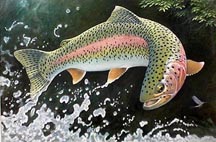






Email Me by
clicking below

|
Prince Nymph
Click Here for a Larger Image
Hook: Wet Nymph #8-#16
Thread: Black 6/0
Body: Peacock Herl
Hackle: Hungarian Partridge
Rib: Copper Wire
Horns: White Goose Quills
Tail: Black or Brown Goose Quills
Optional: Gold, Copper or Brass Beadhead
Tying Instructions:
If you are tying the beadhead variety of this fly first you want to slip the bead on. Now attach your thread and tie in the tail quills. These are two black goose quills that are tied down in a V shaped fork. Now attach your copper wire a couple of peacock herls (the number varies with the size of the herl and the size of the hook). Wrap your thread to the eye or to the base of the beadhead. Now wrap your peacock herl forward, tie down and trim off the excess. Now wrap your thin copper wire forward. You may not be able to see the copper wire after it gets embedded in the fly. This is ok because the copper wire is really only there to help reinforce the peacock herl. Now tie in you piece of hackle. The hackle is meant to look something like that off of a soft hackle fly, it is not meant to stick straight out like a dry fly. Now attach the horns of the fly in a V shape the same was as the tail. Tie off for your finished fly.
Fly Information:
This is one of those old flies that is still around because of the fact that it works so well. To my knowledge there are no insects with those peculiar looking horns in the water, but the fish don't seem to mind. I probably use this fly more than any other nymph, mostly because of its versatility in both the lakes and streams. This is also a very good fly for the backcountry. This fly was originally called the Brown Fork Tail and was first used by Doug Prince. The reason for the name is it is sometimes tied with a brown tail instead of black.
|



